Intel Launches Xe-LP Server GPU: First Product Is H3C’s Quad GPU XG310 For Cloud Gaming
by Ryan Smith on November 11, 2020 9:01 AM EST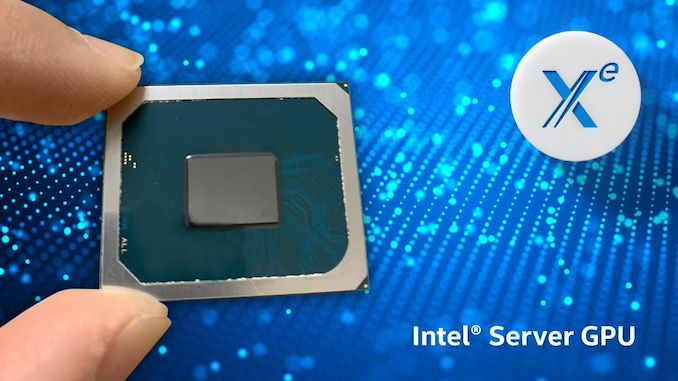
Following the formal launch of Intel’s first discrete GPU in over a generation, the DG1, this morning Intel is launching the server counterpart to that chip, the very plainly named “Intel Server GPU”. Previously referred to as SG1, the Intel Server GPU is based on the same Xe-LP architecture design as the DG1, but aimed at the server market. And like the consumer DG1, Intel is planning on taking an interesting, somewhat conservative tack with their new silicon, chasing after specific markets that are well suited for Xe-LP’s significant investment into video encode hardware.
One such market that Intel has decided to chase with their new silicon is the Android game streaming market. The company sees both gaming and video as growth markets, and game streaming is the perfect intersection of the two. So, with an expectation that Android cloud gaming is going to greatly grow in the coming years – especially in China – the company is positioning the GPU the hardware and developing a suitable software stack to use the Server GPU for hosting Android games in the cloud.
As for the Server GPU itself, it is virtually identical to the DG1 that was unveiled barely two weeks ago. That is to say that it’s essentially a discrete version of Tiger Lake’s integrated GPU, offering 96 EUs and 24 ROPs, and bound to a 128-bit LPDDR4X memory bus. The one notable difference here is that while DG1 laptop implementations are all using 4GB of VRAM (thus far), Intel expects Server GPU installations to get 8GB per GPU.
In any case, the mobile versions of this silicon get what Intel estimates to be around NVIDIA MX350-levels of performance, which is admittedly nothing to write home about. Server GPU should do better than this thanks to its higher clockspeeds and TDPs, but not extensively so. As a result, the best use cases for Intel’s first discrete GPU are not big, shader-bottlenecked games or other rendering tasks, but rather tasks that take advantage of the dGPU’s compute capabilities and/or extensive media encode hardware.
This brings us back to Android cloud gaming, which by its very nature relies heavily on video encoding. The name of the game, as Intel sees it, is all about enabling high-density server installations for game streaming at a lower total cost of ownership (read: cheap), with Intel taking a particular pot-shot at rival NVIDIA over their software licensing costs. Ultimately, with their Server GPU they believe they can meet those specific demands.
And while the Server GPU isn’t going to be setting any performance records, it should still be well ahead of most mobile SoCs – and particularly the kind of lower-performance SoCs that go into the bulk of Android phones. So even at its modest performance levels, Intel is estimating that a single Server GPU can power between 10 and 20 game instances, and that number scales up significantly when you start talking about multiple GPUs.
To that end, Intel has even worked on developing the necessary Linux drivers and modules to support Android game streaming workloads, in order to bootstrap the market. Which for Intel means not only developing the base kernel drivers, but also the necessary tools for gaming-focused virtual machines, and even some internal projects to improve game streaming performance. Of particular note here is what Intel is calling Project Flip Fast, which is intel’s optimized client game streaming stack. Among other things, the company has enabled zero copy transfers between the host and the guest in order to avoid the performance hit from copying data between the two levels.
But Intel can only take their Server GPU so far on their own. Not unlike their CPU market, Intel isn’t interested in selling whole systems – or in this case video cards. So the company is working with third parties to bring the Server GPU to market in commercial products.
In conjunction with today’s launch of the Server GPU, Intel is also announcing their first customer and the first product using the GPU: H3C’s new XG310 game streaming card. The pathfinder product for the Server GPU, the XG310 is a quad GPU card aimed specifically at the Android game streaming market. The card offers 8GB of LPDDR4X per GPU, for a total of 32GB of on-board VRAM. Meanwhile connectivity is provided via a PCIe 3.0 x16 connection, which from the looks of the card is being fed into a PLX PCIe switch before being distributed out to the individual GPUs.
The XG310 is intended to be sold to server OEMs and game service providers, and Intel has already enrolled Tencent to show off the card. According to the company, a single XG310 card is able to run 60 streams of Arena of Valor at 720p30, and doubling the number of cards doubles the number of streams, which feeds back into Intel’s overall TCO argument.
Ultimately, as things stand, H3C’s Intel-based card is being validated with servers now. And, according to Intel, it’s already shipping worldwide with orders having already come in. The first customer for it is likely to be Tencent, who will be introducing their own cloud gaming service. Otherwise, thought Intel isn’t talking about any other customers at this time, it’s clear that they’re eager to line up more Android game streaming providers in the future. As well, these style of multi-GPU cards would also be a good fit for Intel’s more traditional high-density media encode customers, whom were previously buying things like Intel’s Visual Compute Accelerator cards.


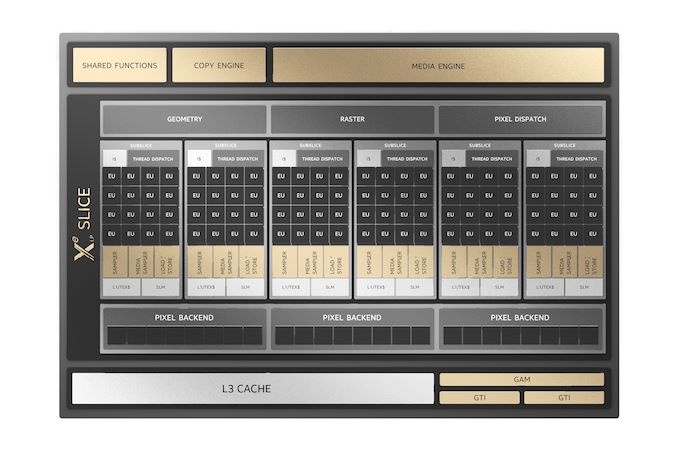
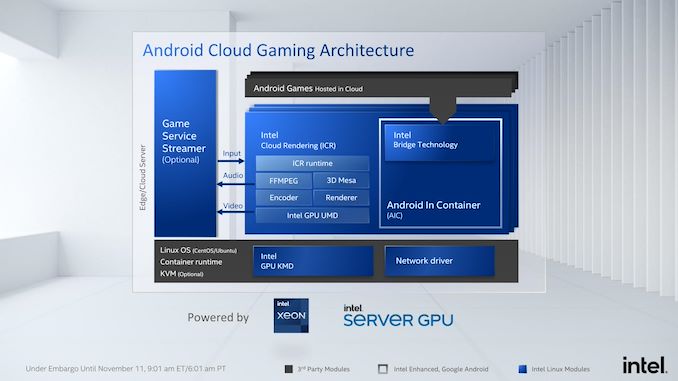
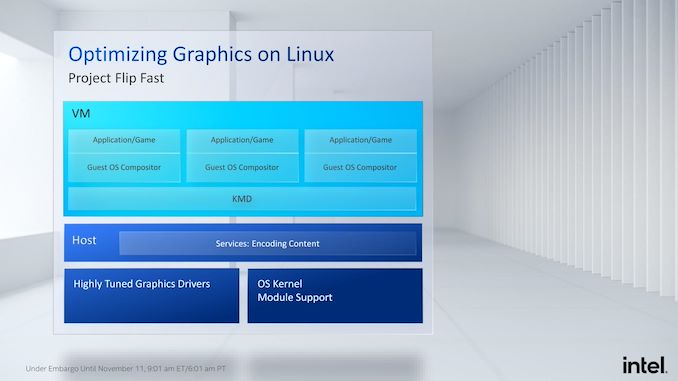
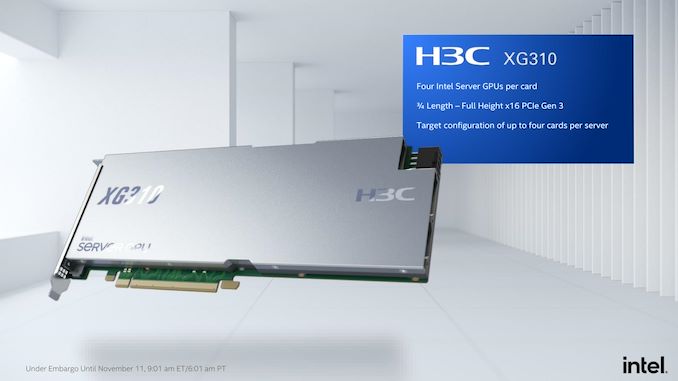
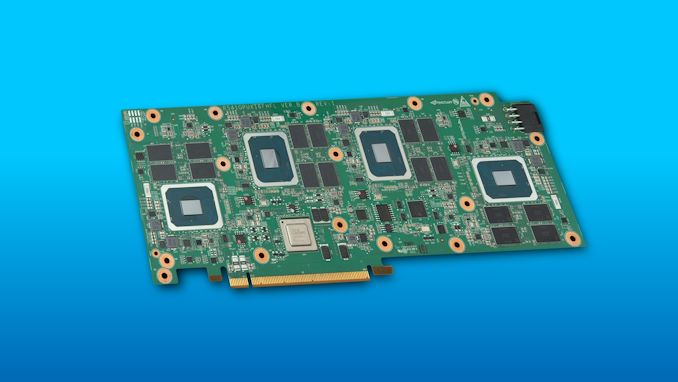
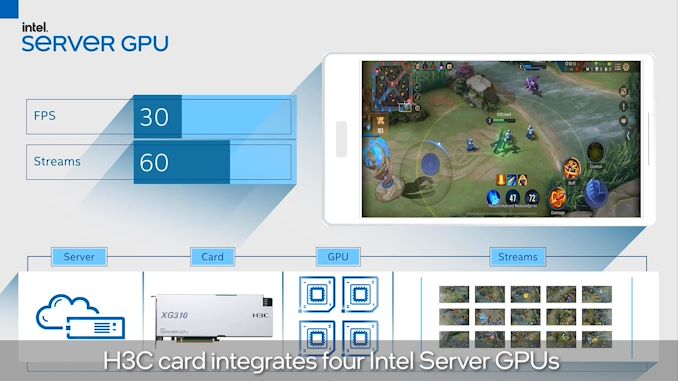
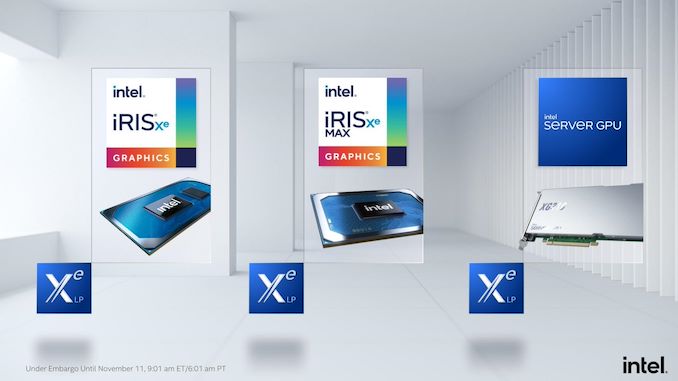








23 Comments
View All Comments
Ryan Smith - Wednesday, November 11, 2020 - link
I noticed it as well. I'm assuming someone took a top-down shot and then stretched it to fake being at an angle.MrCommunistGen - Wednesday, November 11, 2020 - link
Ah, that makes sense. I see the distortion now. The PCI-e power connector looks oddly flat.When I first saw the photo I was like: "Are they using different package sizes for the 2 GPUs in the middle vs the GPUs on each end...?"
alexvoda - Thursday, November 12, 2020 - link
Silly that they did this when you have 3D transforms in both Photoshop and Gimp.Kevin G - Wednesday, November 11, 2020 - link
This should also be transcoding beasts for conversion or other video work. My only quibble is that they went with LPDDR4X instead of DDR4L and some SO-DIMM slots to large memory pools. Conceptually that'd double the memory capacity of the card with just one SO-DIMM per channel.lmcd - Wednesday, November 11, 2020 - link
I'd assume it's a question of what the controller is optimized for. Tiger Lake looks like it's effectively LPDDR4X-only (no designs are using even DDR4L) and Xe gen 1 looks like it's just using a lifted Tiger Lake memory controller. I'd imagine that the memory controller (since it's shared with the CPU) was the part that Raja (or whoever set the roadmap) looked at and said "eh good enough for round 1, let's fix these 5 fires over here first."Spunjji - Thursday, November 12, 2020 - link
If it's Tiger's memory controller, it'll be interesting to see if they ever release LPDDR5 variants.quorm - Wednesday, November 11, 2020 - link
How popular is game streaming? I haven't really seen any data on users/paid users. Is the market growing?PaulHoule - Thursday, November 12, 2020 - link
Remember how Netflix was a big hit and then it seemed many of the big companies said "me too" and started a TV service?It's the same with game streaming, except in this case some executive was watching TV and saw an ad that says "Verizon has the best 5G network" and thought it was for real, then then other executives thought "What's our 5G strategy?" and they thought "game streaming".
It's particularly a hoot that this board plays Android games. I mean... Really?
I use Bluestacks to manage the IoT devices in my house that couldn't be bothered to make a PC application to control them. It always harasses me with ads for Android games that allegedly somebody plays somewhere. The screenshots look OK, but really? If I've got a PC that can handle Bluestacks I've got a PC that can handle Steam.
I have a NVIDIA shield and from the viewpoint of gaming it's a joke. I think the hardware is OK, the OS is busted, and the games are weak. I played through "Record of Agarest Wars" on it and the glitches were not that much of a distraction.
"Big Tech" is going to lose billions of dollars in game streaming and I just wish there was some prediction market that would funnel some of that money to the people who will be telling them "I told you so" next year.
kmizuno - Wednesday, November 11, 2020 - link
Tencent supposes to develop a cloud game platform with Huawei, using Huawei's Arm servers for Android cloud gaming. Can anybody know Tencent changes their strategy or not? Arm on arm looks more compelling solution for android. Now Intel is focusing on Android cloud gaming with their GPU working with Tencent. So Intel is seeking an opportunity of Tencent cloud as well. Correct?Spunjji - Thursday, November 12, 2020 - link
I suspect it's the first place they were able to... *ahem* "persuade" to take some of these on for testing.